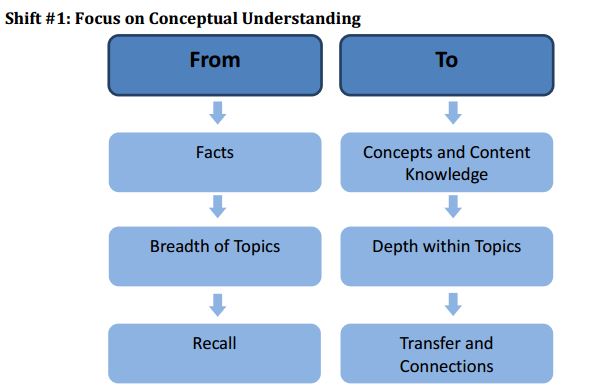NYS Social Studies Standards
Beginning in 2014, the NYS Education Department has updated its expectations on how K-12 social studies curriculum is taught. The changes are meant to increase the rigor of instruction and better prepare our students for life as civic-minded citizens. The information below outlines what has remained the same and what has changed.
What's the same?
The 1996 NYS Social Studies Learning Standards will continue to provide the basic foundation for the social studies content and the newly developed Social Studies Framework. The five learning standards are as follows:
Standard 1: History of the United States and New York
- Students will use a variety of intellectual skills to demonstrate their understanding of major ideas, eras, themes, developments, and turning points in the history of the United States and New York.
Standard 2: World History
- Students will use a variety of intellectual skills to demonstrate their understanding of major ideas, eras, themes, developments, and turning points in world history and examine the broad sweep of history from a variety of perspectives.
Standard 3: Geography
- Students will use a variety of intellectual skills to demonstrate their understanding of the geography of the interdependent world in which we live—local, national, and global—including the distribution of people, places, and environments over Earth’s surface.
Standard 4: Economics
- Students will use a variety of intellectual skills to demonstrate their understanding of how the United States and other societies develop economic systems and associated institutions to allocate scarce resources, how major decision-making units function in the United States and other national economies, and how an economy solves the scarcity problem through market and nonmarket mechanisms.
Standard 5: Civics, Citizenship, and Government
- Students will use a variety of intellectual skills to demonstrate their understanding of the necessity for establishing governments; the governmental systems of the United States and other nations; the United States Constitution; the basic civic values of American constitutional democracy; and the roles, rights, and responsibilities of citizenship, including avenues of participation.
The chart below identifies the basic content focus for each grade level.
| Grade | Content Focus |
| Kindergarten | Self and Others |
| Grade 1 | My Family and Other Families, Now and Long Ago |
| Grade 2 | My Community and Other Uniter States Communities |
| Grade 3 | Communities Around the World |
| Grade 4 | Local History and Local Government |
| Grade 5 | The Western Hemisphere |
| Grade 6 | The Eastern Hemisphere |
| Grade 7 | History of the United States and New York - I |
| Grade 8 | History of the United States and New York - II |
| Grade 9 | Global History and Geography - I |
| Grade 10 | Global History and Geography- II |
| Grade 11 | United States History and Government |
| Grade 12 | Participation in Government Economics , the Enterprise System and Finance |
What's Changed?
The introduction of the NYS Social Studies Framework in 2014 combines several existing documents into one. The SS Framework, in essence, puts forth “the what” of social studies instruction. Below is the description from the Engageny website (linked above; emphasis added):
The New York State K-12 Social Studies Framework is designed to prepare students for college, careers, and civic life with courses that are rigorous and aligned to New York State Learning Standards, both Common Core and Social Studies. This Framework integrates existing New York State Learning Standards and the New York State Core Curriculum for Social Studies into a single, three-part document. It is intended to serve as a guide for local districts in developing their Social Studies curricula. It incorporates the New York State Common Core Learning Standards and recommends the use of the C3 Inquiry Arc as instructional methodology. Social Studies practices are identified, as well as the key ideas, conceptual understandings, and content specifications.
Below are short explanations of key components included in the Framework. More information on how these features work within the SS Framework can be found at the link above.
NYS Common Core Learning Standards
- Teachers are expected to incorporate the NYS Common Core Learning Standards for ELA and Literacy in History/Social Studies into the social studies curriculum, specifically the anchor standards for Reading, Writing, Speaking & Listening.
College, Career, and Civic Live (C3) Framework and Inquiry Arc
- In 2013, the National Council for the Social Studies published the C3 Framework. The C3 Framework consists of the following components: the Inquiry Arc, Disciplinary Literacy, and Civic Life. All three components influenced the design of the NYS SS Framework, especially the inquiry approach to student learning. The graphic below demonstrates how the NYS Framework and the Inquiry Arc support one another.
Through an inquiry-based approach, students develop thematic and conceptual understanding while applying disciplinary practices and literacy skills in the context of content.

Social Studies Practices
Teachers are expected to foster the following social and historical thinking skills in their units of study:
- Gathering, Interpreting and Using Evidence
- Chronological Reasoning and Causation
- Comparison and Contextualization
- Geographic Reasoning
- Economics and Economic Systems
- Civic Participation
The SS Framework offers a more detailed progression of how these skills should be developed across the grades.
NYS Social Studies Field Guide
Just as the SS Framework defines “the what” of social studies instruction, the SS Field Guide defines “the how”. The purpose of the Field Guide is to highlight the following instructional shifts:



An example unit is included in the Field Guide to illustrate how these shifts would manifest themselves in the teaching and learning process.
NYS Social Studies Toolbox
Not yet available
If you have any questions, please contact the District Office at 655-1317.




